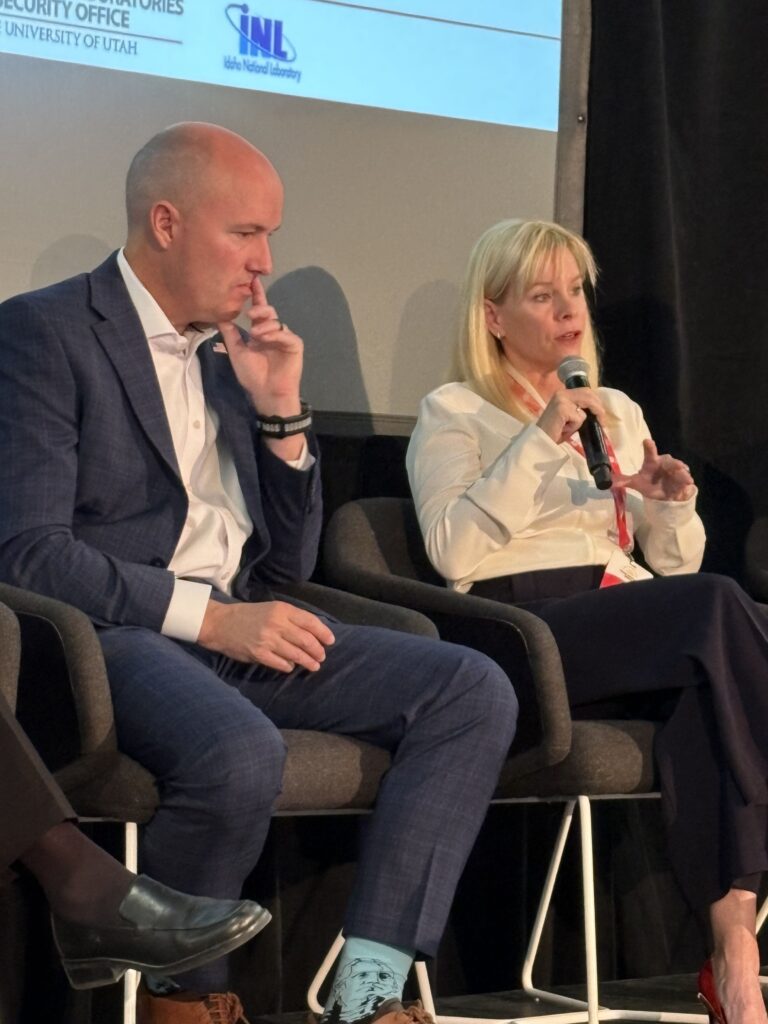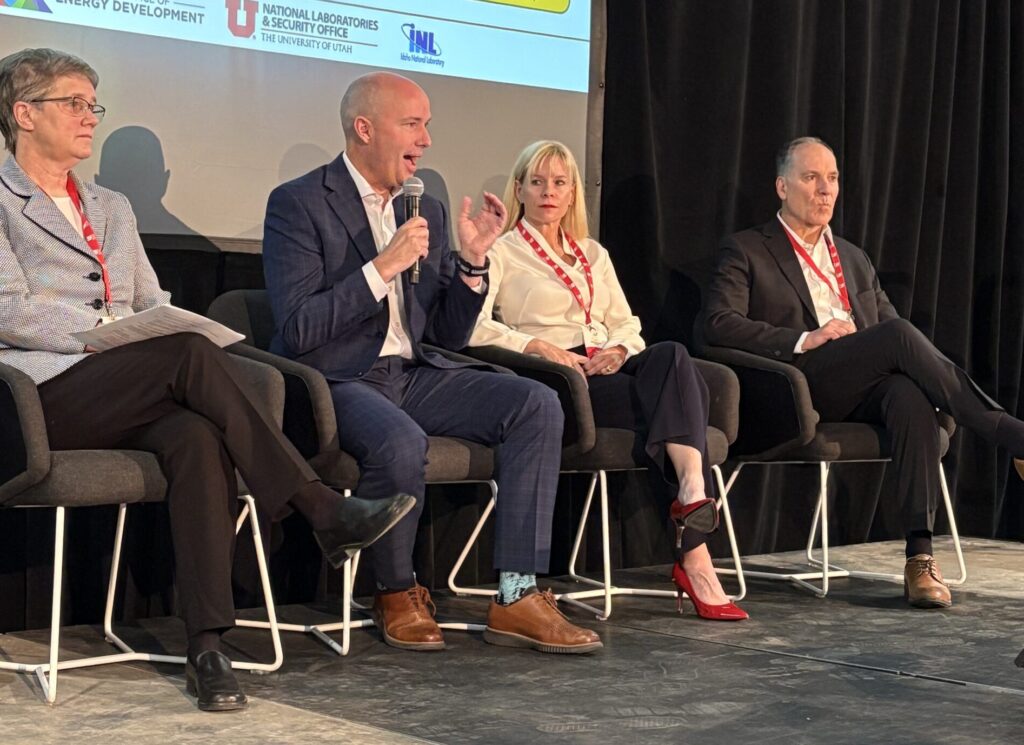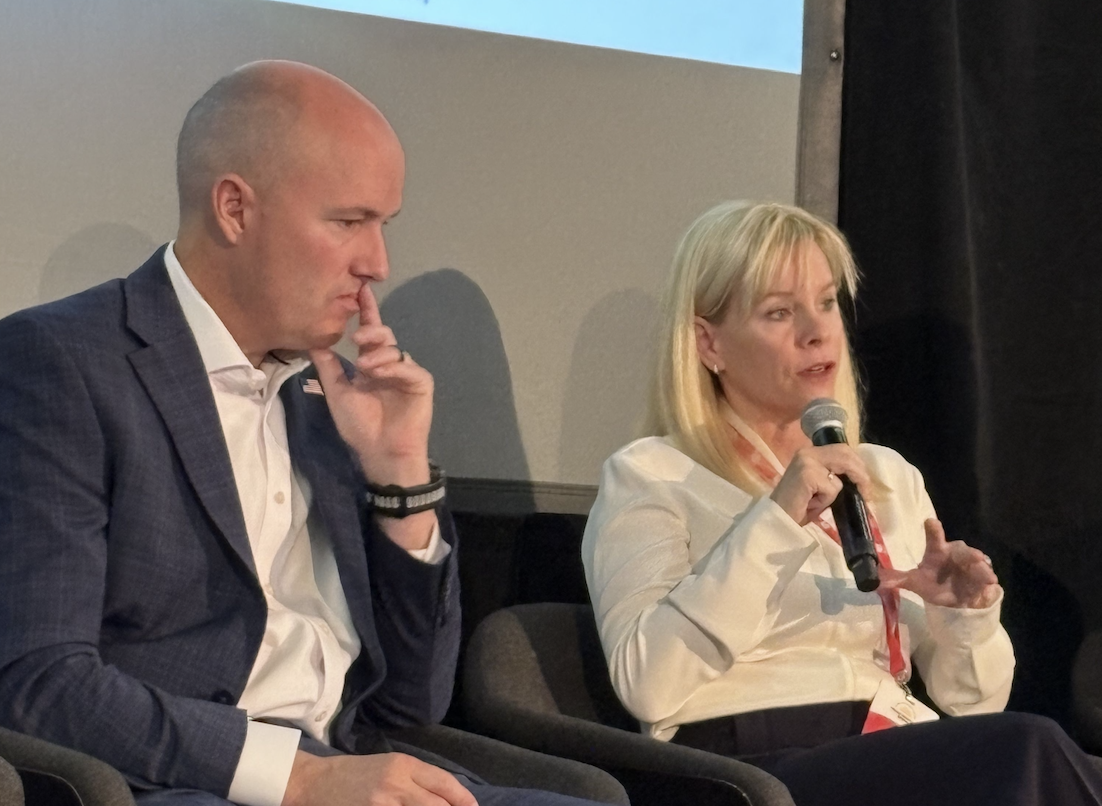By Xoel Cardenas, Sr. Communications Specialist, Office of the Vice President for Research
At last week’s Utah Energy Week, the first hosted by the University of Utah’s Office of the Vice President for Research (OVPR), Governor Spencer Cox and University of Utah Vice President for Research Erin Rothwell outlined a shared vision: Accelerate innovation, strengthen partnerships, be bold and educate our future workforce earlier to help strengthen Utah’s energy and economic future.
“Everything we do depends on energy,” said Cox. “And I think we’ve taken that for granted for quite a long time. We have to set a vision for the future. And our vision is that we know we have to double our energy capacity here in Utah over the next few years just to be able to keep up. And again, we saw this coming, so we have to move very quickly.”
 Photo credit: Xoel Cardenas, University of Utah
Photo credit: Xoel Cardenas, University of Utah
With energy demand soaring, artificial intelligence transforming industries, and global competition growing each day, state leaders say it’s going to take swift action to help position Utah to be not only energy dependent but also be an energy leader in the region while creating economic growth.
“How the state of Utah responds in the next three to five years will dictate the next 20 years,” said Rothwell. “We have to start thinking about national security, global competitiveness, and economic stability and moving our research in that area to support the state.”
Cox and Rothwell were part of a morning panel discussion at Utah Energy Week that also featured Dr. Lisa M. Berreau, Vice President for Research at Utah State University, and Dr. John Wagner, Laboratory Director at the Idaho National Laboratory. The leaders discussed several energy topics, including the power of research partnerships to drive and realize energy innovation, development, and deployment.
Taking Calculated Risks
For Gov. Cox, finding innovative ways to solve Utah’s energy demands will require taking risks, something that isn’t always embraced. “I’ve heard the term de-risking several times right now. And I appreciate that term because I think it’s really important. But de-risking means that someone has to take a risk. And it’s who’s going to take that risk that matters,” Cox said. “And so our willingness as a country collectively to say, ‘we’re going to take some risks, we’re going to take some swings. We used to do this. We have to stop being risk averse and as a country we have to take some swings, which means we’re going to miss on some of these. We have to be willing to say that’s ‘okay, we took a swing, it didn’t work, we’ll figure something else out.’”
Rothwell shared those sentiments, citing the Utah FORGE geothermal project in Milford, Utah, as an example of the power of taking calculated risks. “We didn’t know if it would work,” she said. “That’s the role of a university: taking risks, pushing the envelope.”
The Role Higher Ed Plays in Energy Innovation
Rothwell outlined how universities must evolve. “I see a new role for universities,” she said. “We need to partner with our national labs and industry partners, and not worry so much about IP, but what is it going to take to get the technology from testing to scaling.”
The University of Utah is already taking steps in this direction through its National Laboratory & Security Office, which connects faculty with federal labs and strengthens collaborations in areas like energy, defense, and national security.
The U is taking the lead, but more infrastructure, collaborations, government support needed
The University of Utah secured nearly $800 million this past year in federal and industry funding ($791M)—a significant source for developing new energy technologies. Rothwell emphasized that translating these technologies requires more than funding alone.
 Photo credit: Xoel Cardenas, University of Utah
Photo credit: Xoel Cardenas, University of Utah
“We have to build the infrastructure to translate the technologies to the marketplace. We have to test, scale and deploy, she said. So one of the things that I see the University of Utah doing is pursuing those partnerships to accelerate those technologies.”
Cox also spoke on the importance of public policy changes that might be needed in order to allow researchers and innovators to work on finding discoveries.
“It’s sometimes public policy that holds back the ability of those with capital and innovation to do their jobs,” he said. “We have laws in place that don’t allow you to do that. And so we’ve made big strides… for several really impactful and sometimes first-of-their-kind donation bills that are going to allow people with vision and needs to actually build the energy that we need in the present.”
Training Utah’s workforce today and beyond
Cox and Rothwell both underlined the urgency of preparing Utah’s workforce earlier to expand career options and meet the demands of energy growth.
“We have to get work earlier into education and we have to get education later into work as we continue to learn new skills and have new opportunities,” said Cox. “It’s the one area where I think the European model is a little better where they’ve tied work and education together at a much earlier age to help kids figure out what they want to do… We’re working to do a lot more of that, a lot more apprenticeship work giving kids opportunities to get into off-campus and somewhere else to see how it all works. I think having a skill and having a degree; we should be pushing both of those things.”
Rothwell highlighted a shortage of engineers and science, technology, engineering, and mathematics (STEM)-trained workers poses a critical challenge.
“We do not have enough engineers in the state,” she said. “The pipeline is not there for STEM workforce. So how we (at the University of Utah) are interacting and rethinking how we are interact with the public school systems and bringing in exposure to those STEM fields.
Investing today for tomorrow’s Utah energy success
While Gov. Cox and VPR Rothwell represent two distinct areas — policy and research — both of them share a common vision and goal: Utah is positioned to lead in energy innovation today and in the future. Investing in Utah’s energy future is not an option, it’s a must.
“Having this conversation on the stage is heartening to me,” said Cox. “Having these partners in higher ed understanding their role in making this change happen. There is this awakening happening, understanding that we have this moment in time right now, that there are huge opportunities for investment. We have to continue to invest.”
“We’ve got to move forward with the next generation of technologies,” said Rothwell. “The way that I see this playing out is how do we help change basic science to deployment faster and quicker.”
The discussion reflects the University of Utah’s five-year Research Strategic Plan, which emphasizes accelerating innovation, strengthening partnerships, and developing a skilled workforce to meet state and national priorities.
Related story: Powering Progress Together: Utah Energy Week Brings Voices Across Sectors to Build a Resilient Energy Future
